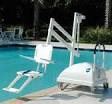Swimming is great exercise as well a great way to relax. And spending time in a swimming pool can be very therapeutic for most people. However, for individuals with certain disabilities or mobility challenges, getting in and out of a pool can be very difficult, or even impossible without some type of aid. Fortunately, over the years, there have been many in almost any situation.
Basically, a pool lift is any mechanized seat with the ability to lower and raise a disabled or injured person into and out of a swimming pool. Pool lifts can either be permanent or portable. Permanent pool lifts can be installed on the edge of a pool, or onto an anchor embedded in the pool deck, while portable lifts, which usually have wheel attachments, can be placed anywhere around the pool, and then put in storage when not in use.
As with any type of product, different types of pool lifts have their own advantages and disadvantages. For example, permanent pool lifts are preferable in instances where the individuals needing them are heavier than normal, but, unlike portable lifts, they are always open to the elements.
The first commercially successful water-powered, swimming pool lift hit the market around 1980. By 1997, manufacturers had perfected a battery-powered, free-standing pool lift that was designed to work with more contemporary swimming pool designs. All types of patient lift systems, including pool lifts, are regulated by the U.S. Food and Drug Administration and must meet certain standards in their design and manufacture.
Swimming pool lifts can be categorized as follows: • Non –cantilevered lifts have seats that are attached to and rotate around an anchor point. Most early lifts were of this type as they are limited to simple pool designs that feature either no gutter of recessed gutters. They are fairly inexpensive and easy to operate, but they must be fixed in place to a deck or anchor and connected to a water supply to power them.
• Cantilevered lifts are designed to allow the seat to extend out from the anchor point. They can be fixed, anchored or free standing. Cantilevered lifts provide access to a greater number of pool designs, including rim-flow gutters, roll out gutters, or any type of design where there is a substantial horizontal distance from the loading point to the water. They are further categorized as non-rotational and rotational: o Non-rotational cantilevered lifts extend the seat directly out from the loading point.
o Rotational cantilevered lifts have the added ability to raise and rotate the seat position over the pool deck and extend it over any obstacle in the path to the water. This type of lift provides the greatest versatility of any of the different designs. They can be anchored or free standing, with free standing models generally the most expensive.
Pool lifts in public pools are regulated by the American with Disabilities Act, and as such, cannot be manually operated, as the law requires that they be capable of unassisted operation. However, manually operated pool lifts can be used in a residential setting.
Pacific Mobility has many pool lift options to choose from. We invite you to talk to one of our professional staff members who will help you determine what kind of pool lift best suits your needs and budget. Call us today for a free consultation.
President, Husband, Father, Grandfather Graduate of UC Davis- Bio Sci Major- Go Aggies! Jeff has extensive experience in all of Pacific Mobility’s products and services, and specializes in accessibility products as well as stairlifts, ceiling lifts and custom wheel chairs. His hobbies include spending time with family, gardening, mountain biking, exercising and off road motorcycle riding.
24 years as Owner/President of Pacific Mobility Center – selling, installing, and servicing stairlifts, porch lifts, ceiling lifts, pool lifts, handicap ramping, specialty wheelchairs, scooters, power wheel chairs, and other power mobility devices
Certified Environmental Access Consultant since 2008
Licensed General Contractor since 1998
Certified Aging in Place Specialist since 2016
Board Member for Home Access Professionals
Member of Association of Members of the Accessibility Equipment Industry (AEMA)




